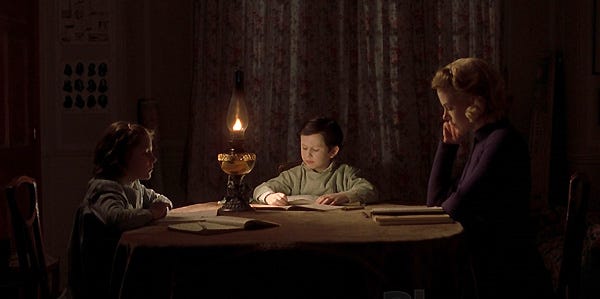A guide to exploring a film’s cultural identity
The easy answer: Låt den rätte komma in (2008)
Film students often need to determine where a film is from, whether for analysis, comparative studies, or understanding of cultural context. Sometimes, the answer is straightforward. Take Låt den rätte komma in (Let the Right One In, 2008), directed by Tomas Alfredson. A Swedish film, adapted from a Swedish book, filmed in Sweden, with a Swedish cast and crew. No debate. It is a Swedish film.
The complicated case: The Others (2001)
But what about a film like The Others (Los otros, 2001), written and directed by Chilean-born Spanish filmmaker Alejandro Amenábar? It is filmed in English, produced in Spain, and distributed by international companies, a true multinational co-production.
At first glance, you might call it a Spanish film because of Amenábar’s strong influence and the backing of Spanish production. However, it is not that simple. Understanding a film’s origin often requires deeper consideration, especially when multiple countries and cultures contribute to its creation.
What determines a film’s origin?
Ask these questions:
Who funded it? Which countries or institutions provided the money?
Who produced it? What production companies were involved?
Where was it shot? The physical production location often reveals key connections.
What language is it in? The language can indicate the intended primary audience.
Who created it? The nationality of the director and creative team may influence its identity.
Where did it premiere? Release strategy, including the country of first release, can shape perceptions of origin.
Why it matters
Understanding a film’s origin isn’t just academic, it impacts:
Awards eligibility - Films must declare an origin to qualify for categories like Best International Feature at the Oscars.
Cultural identity - Ownership of a film’s identity influences how audiences and critics receive it.
Market influence - Many international films use English to cater to global audiences, complicating their cultural identity.
Case study: The Others
Here’s how the evidence stacks up:
Arguments for a "US Film"
Primary language - It’s in English, targeting the global and especially U.S. market.
Release strategy - Premiered in the U.S. before Spain, with marketing aimed at U.S. audiences.
Hollywood appeal - With its psychological horror genre, Nicole Kidman’s star power, and Hollywood-style execution, it aligns with American cinema.
Arguments for a "Spanish Film"
Director’s influence - Alejandro Amenábar is a Spanish filmmaker, shaping the film’s creative identity.
Production location - Shot in Spain, employing Spanish crew members.
Financial backing - The main production company, Sogecine, and significant funding were Spanish.
Contextualizing origin through cultural context:
When analyzing a film’s origins, considering cultural contexts can help untangle its identity. Factors like economic, geographical, and institutional influences often provide the clearest evidence of where a film “belongs.” While there are other cultural contexts to consider and many ways to approach this question, these three offer the most concrete insights into The Others' origin:
Economic context
Spanish lens - Substantial Spanish financial backing through Sogecine was critical to the film’s production.
U.S. lens - Nicole Kidman’s star power and the U.S. box office were essential to the film’s global success, reflecting Hollywood’s economic dominance.
Geographical context
Spanish lens - Shot in Spain, with a significant number of Spanish crew members. The geographical production roots are undeniably Spanish.
U.S. lens - The film’s English dialogue and undefined setting make it geographically ambiguous. Theoretically, the film could be set in the US
Institutional context
Spanish lens - Co-produced and funded within Spain’s European production framework, with significant Spanish involvement.
U.S. lens - Distributed by Miramax, benefiting from Hollywood’s global reach and marketing power.
Conclusion: A hybrid identity
From a Spanish perspective, The Others is a homegrown success, a product of Spain’s financial, creative, and technical resources. From a U.S. perspective, it’s an American film in language, genre, and marketing.
This duality makes The Others an excellent example for exploring cultural contexts in film. It challenges students to think critically about a film’s origins and to consider how different lenses (economic, geographical, and institutional) shape our understanding.
So, next time you ask, “Where is this film from?” remember: the answer might be more complex.








